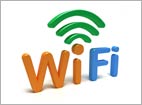The billions of things that are part of everyday life would be useless if they didn’t work together. If an airtight system doesn’t connect widget A snugly to gizmo B, all would be lost. It’s true for garden hoses and spigots, keys and ignitions, electrical plugs and outlets and hundreds of other things we use daily.
It’s also true in telecommunications and consumer electronics, from Wi-Fi to text messaging to smart phones and beyond. In fact, Lee Badman at Network Computing lauds the Wi-Fi Alliance for what he considers to be pioneering work in advancing interoperability in the Wi-Fi realm.
Badman feels that the alliance deserves a lot of the credit for the phenomenal rise of Wi-Fi during the past decade. But he also sees problems. Badman says that the shortcomings of Wi-Fi interoperability testing are leading enterprise IT folks to scramble. The Alliance, he writes, goes far – but not far enough:
Despite lofty promises of compatibility, conformance, and interoperability, WLAN administrators far and wide deal with the gaps created by what’s left out of the testing.
Badman implies that the security requirements of the enterprise and even beyond that, the special needs created by rules and regulations such the Health Insurance Portability and Accountability Act (HIPAA), can make devices only partially interoperable. That means, of course, that they are not actually interoperable at all. Though it is in transition, Badman points to the use of Google Glass by a surgeon as an example of where Wi-Fi interoperability falls short today.
The vast numbers of new types of equipment and systems reaching corporate LANs will likely widen the gap between Wi-Fi Alliance interoperability as it stands today and what really is needed. It will take time to determine whether the Wi-Fi Alliance will be able to handle this emerging landscape.
But it seems that the organization understands the issue. Robert Vamosi, writing at Forbes, discussed the relationship between the Internet of Things (IoT) to Wi-Fi in general and to the Wi-Fi Alliance in particular. The story, which is based on an interview with Kevin Robinson, the consortium’s director of program marketing, describes how it is gearing up for the future.
Wi-Fi devices are ubiquitous and the number and type, including IoT, is growing. Vamosi writes:
In anticipation of this boom, WiFi Alliance released a new Wi-Fi Certified Product Finder tool that makes it easier for a consumer and IT admins to find thousands of devices that have already gone through the organization’s interoperability certification program. Since 2000, 2300 products have been certified, and the organization is on track to certify up to 5,000 more, in new categories such as automotive, smart home, and wearables, by the end of this year. “That’s relevant for IoT where you have more and more players and you don’t have single companies representing every device category,” Robinson said.
Vamosi also says that the organization has introduced Wifi Aware, a protocol that discovers nearby Wi-Fi-enabled devices and, when they are found, it “asks” if they want to communicate.
The key question is whether the certification programs will grow to the sophistication necessary to meet the deep demands to which Badman refers in his article.
The reality may be that the sophisticated interoperability that is necessary for enterprise IoT applications, especially those in sensitive fields, won’t be handled by the Wi-Fi Alliance at all. Last week, InformationWeek focused on IoTivity, a product of the Open Interconnect Consortium and the Linux Foundation. But it is just one of many contenders. Another major player is the AllSeen Alliance’s AllJoyn. However, a landscape in which the Wi-Fi Alliance handles basic connectivity and alliances such as these higher level functions seems possible.
In fact, an IoT-dominated world may be so complex and the specific needs of each industry so specific that a single organization can’t manage it all. What is clear, however, is that interoperability that is deep and secure is a must.
Carl Weinschenk covers telecom for IT Business Edge. He writes about wireless technology, disaster recovery/business continuity, cellular services, the Internet of Things, machine-to-machine communications and other emerging technologies and platforms. He also covers net neutrality and related regulatory issues. Weinschenk has written about the phone companies, cable operators and related companies for decades and is senior editor of Broadband Technology Report. He can be reached at cweinsch@optonline.net and via twitter at @DailyMusicBrk.




